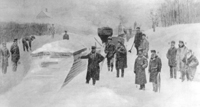The Railways
Canadian Railways in the Mid-1800's
In the 1850's, railway building fever was sweeping North America and the Grand Trunk Railway, a broad gauge (5 foot 6 inch gauge) mainline railway was built from Portland, Maine to Sarnia, Ontario at an enormous capital cost which was not economically viable given the Province of Canada’s economy and population of the time. This failure together with a business depression after a general financial crisis in 1857 and the uncertainties of the U.S Civil War meant that virtually no railways were built in the 1860's in Canada.
With Canadian Confederation in 1867, a renewed demand for new railways drove massive investments in building the Canadian Pacific Railway to tie the country together. This railway was to be routed from Montreal through the Ottawa valley and along the North shore of Lake Superior. The need for a railway to be built northward from Toronto and link to the transcontinental system drove George Laidlaw, an associate of the Gooderham and Worts business interests in Toronto, to champion the development of such a railway.
But he wanted to be able to control costs and avoid going to overseas investors for financial backing. He was influenced by the Chief Engineer of Norway’s railways who was beginning to build 3 foot 6 inch gauge railways due to the high costs of standard (4 foot 8 ˝" gauge) railways.
Both the Toronto and Nipissing and the Toronto, Grey and Bruce narrow gauge railways were built under these economic circumstances.
